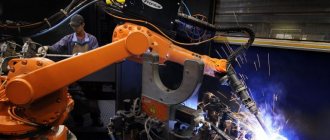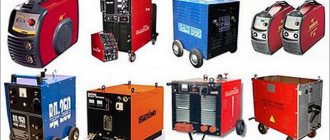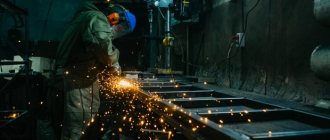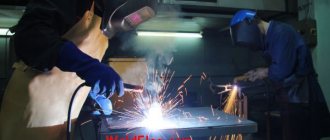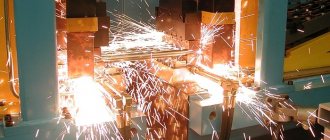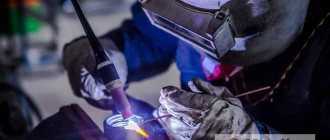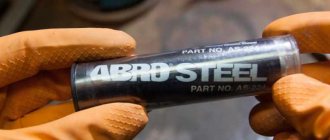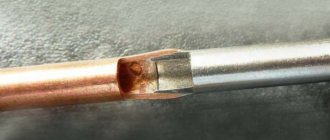Robotic welding is a type of automated process characterized by high precision. Programmable robots replace welders and increase work productivity tenfold. A welding robot is an essential part of a conveyor production where there are welding operations. For example, when assembling cars, household appliances, equipment.
How does a welding robot work?
The operating principle of the devices depends on their type, but all robots have a similar structure.
The basis of the mechanism is the “arm” - several metal beams connected by moving elements. At the end of the manipulator there is a working head, which carries out welding.
“Arm” of the Kuka WTG 1200 welding robot. Photo: kuka.com.
The hand is mobile - the more “joints” it has, the more complex work it can perform. An optical guide is attached to the device, allowing you to accurately select the location for the suture.
The robot is connected to a control panel in which the appropriate software is installed. It is written for each project separately, which allows you to finely customize the capabilities of the machine.
Advantages and disadvantages
Robotic welding optimizes the technological process; robotic machines have replaced welders. Advantages of work automation:
- the quality of connections improves;
- similar operations are performed at the same speed (a person is not capable of this);
- equipment can be reconfigured during operation in a matter of minutes;
- the defect rate decreases;
- stable arc burning is maintained, the interval between the workpiece and the electrode is maintained;
- the operating time is much longer;
- equipment costs quickly pay off due to the elimination of manual labor and increased productivity;
- maintenance costs are disproportionately less than the salary fund of welders with mandatory deductions;
- the operator setting up the equipment acts according to modified algorithms that do not require special knowledge; it does not take long to train him;
- safety - no thermal or radiation effects on people;
- economic effect;
- no control system is needed; this function is performed by a computer.
Now about the disadvantages, they also exist:
- high cost of robots;
- repeatability of operations, you won’t be able to reconfigure the automation, robotic welders are used only in conveyor assembly and mass production;
- The quality of welding work depends on the operator’s experience and ability to set up equipment.
Types of welding robots
Laser
Laser welding robot. Photo kuka.com.
Laser welding is used in many areas: from automotive manufacturing to spacecraft design. It is used to create medium and large sized parts.
During welding, the laser heats the material to its melting point. The beam is focused using optics and, while moving in a straight line, a weld is created. An inert gas, usually argon, is used to protect against oxidation.
Laser technology is combined with other types of connections: spot welding, gluing and sealing.
Advantages of laser welding:
- Low costs due to high connection speed and high efficiency;
- Reliability - the metal is not subject to shock, does not deform or crack;
- Large seam depth with small width.
Arc
Arc welding robot. Photo fanuc.eu.
Arc welding is an umbrella term that includes methods such as MIG, TIG, MMA and others. During operation of the device, an electric arc is formed between the electrode and the metal, which melts the workpiece material at the edges being welded. The electrode can be non-consumable or consumable. In the second case, it melts along with the material and forms a weld.
The most popular non-consumable arc welding method is TIG with a tungsten electrode. Since the element does not melt, an inert gas, usually argon, is used to protect the metal from oxidation.
The main problem with such robots is software that can force the machine to correctly connect parts. The best arc machines are produced by Kuka, Fanuc, Hanwha.
Spot
Point robot from Fanuc. Source fanucamerica.com
Robotic spot welding is the most common type of resistance welding and is used in the production of most metal products.
Most often, spot welding robots are used in the automotive industry to join several metal sheets. But such machines are also in demand in other industries.
Point robot from Kuka. Photo: directindustry.com.
Automating spot welding is a fast, simple and inexpensive solution. Robots save on labor and production time.
Spot welding robots are produced by Kuka, Fanuc, Universal Robots, etc.
Gas
The advantage of this type of welding is the rapid setting of the material. During operation of the device, gas is continuously supplied to the welding tip. This produces a flame, which serves as a source of heating. The metal heats up to a temperature of 2500-3000 degrees.
Gas welding is one of the most popular types of metal joining in industry. It is easily integrated into robotic systems, so automatic devices have long been in mass production. Thanks to robots, this type of welding is the fastest available.
Gas welding. Photo youtube.com
Welding robots can operate in any position, adding flexibility to the process. Modern devices have protection from harmful vapors, the welds are very strong, and the efficiency of the machine allows you to get the most out of it.
Plasma
Plasma robot Kuka. Photo: eurobots.net
Plasma welding technologies are used for complex joints. Thanks to high temperatures, welding occurs almost instantly.
Robotic plasma welding (PAW) is similar to TIG technology. It operates using compressed ionized gas passing through a copper nozzle. This achieves a maximum temperature that allows for a minimum cross-section of the weld. Plasma welding typically uses the same non-consumable tungsten as arc welding.
Robots offer greater operational flexibility with the ability to customize speed and temperature.
Application of robotic machines
For the production of stamped products, where a repeating type of connection is used, welding robots are often installed. Thanks to the programmability, they are able to accurately place straight, circular and circular sutures.
Arc welding in these devices is also used for curved seams of any complexity. Unlike the mechanical templates along which the head moves in other welding machines, robotic welding moves the axes and torch electronically. This has found wide application in mechanical engineering and machine tool manufacturing.
Real examples of using welding robots
Bridge made using welding robots and 3D printing
Bridge frame. View from above. Photo: digitaltrends.com
For three years, the Dutch company MX3D has been working on creating the most unusual steel pedestrian bridge in the world. Its frame is made in the form of twisted metal beams, creating a futuristic style. The design will have a real use - it will be installed over a canal in Amsterdam.
But the most interesting thing is that the bridge is created only with the help of welding robots. The developers took devices usually used in the automotive industry and working on MIG arc welding technology.
The manufacturing method uses 3D printing. The software allows you to build up new layers of metal of complex shape using ready-made models.
Ready design. Photo: digitaltrends.com
The original plan was to install robots directly above the canal and print the bridge in place. But, due to the complexity of implementation, the design is created in the workshop.
The finished bridge is 12.5 meters long and took six months to build. 4500 kg of stainless steel and 1100 km of wire were used for printing. The developers plan to put the product into operation in 2022.
Bridge edge printing process. Photo: digitaltrends.com
3D printed bicycle
A finished bike with a printed steel frame. Photo newatlas.com
Another unusual example of the use of welding robots is a stainless steel bicycle made using 3D technology.
This bike can be ridden on city streets and off-road. Photo newatlas.com
This is not the first bike to be made using automatic systems. Previously, frames were made using laser welding from ready-made components. The same student project involves the use of 3D printing in conjunction with a robotic welding system.
This is the first bicycle created using 3D technology and welding robots. Photo newatlas.com
The robot creates a ball of molten metal, then adds another one on top of it once it has solidified. This creates beams that are welded to form a frame.
The creators have no doubt about the strength of the structure. Photo newatlas.com
The final product, called the Arc Bicycle, weighs about the same as a regular steel frame bicycle and is quite capable of off-road riding.
Team of bicycle creators. Photo newatlas.com
Mini robot from Kuka is one of the smallest and most productive automatic welding machines
The compact size of this model will save working space. Photo: maschinenmarkt.vogel.de
Kuka has released one of the smallest stationary welding robots - WTG 1200. Its working cell dimensions are only 1200x800 mm - this is the smallest automatic welding machine with arc welding technology.
The device has a load capacity of 6 kg, and is optimized for operation at particularly high speeds. Control is carried out using the remote control; you can turn on automatic or manual mode.
The developers have implemented protection for workers. While the doors to the materials storage room are open, the machine will not start.
The device has already been implemented in various industries. As practice has shown, with the help of this robot, productivity has increased by up to 50% due to the high speed of the system.
Hyundai uses welding robots in ship production
Hyundai Heavy Industries (HHI), one of the largest shipbuilding companies in the world, has developed a miniature welding robot for its employees. You can carry the device with you, and then attach it to the ship using magnets. A small robot increases labor productivity by two to three times.
The device weighs only 15 kg, height - 15 cm, length - 50 cm. The working “arm” consists of six joints, making it as mobile as a person’s. The device is able to function continuously, thereby its performance is much greater than that of a person.
The small size provides an advantage not only in transportation. The robot is able to reach hard-to-reach places where a person is unable to work. HHI is used not only in shipbuilding, but also in the maintenance of offshore oil rigs. Therefore, the robot received several types of software that allow it to perform various actions on offshore construction sites: cutting steel, blasting and painting.
In addition, productivity is at least doubled, since one worker can simultaneously control two or three robots.
The mini-robot is able to reach the farthest parts of the structure. Photo newatlas.com
general information
Robotic welding is a type of automatic welding, the essence of which is the use of programmable robots in production instead of conventional welders. Such welding is in great demand at enterprises where it is necessary to set up large conveyor production.
There are a huge number of varieties of welding robots, as each manufacturer strives to equip its equipment with special functions. Despite the technical complexity, competition among manufacturers of welding robots is very high, because such equipment is expensive and is often purchased for more than one year. Therefore, manufacturers are trying to equip their robots with the maximum number of useful functions.
Budget, but relatively functional robots are produced by the Japanese company Fanuc. Their most popular model is the AM-0iA. German welding robots from Kuka are popular among European manufacturers, especially their budget model KR5. We also note welding robots from the world-famous company Panasonic, in particular their model TA1400G2 has proven itself well in domestic factories. Motoman's products performed well; the EA 1400N model deserves special praise.
Recommended Equipment
The following companies are engaged in the production of automatic equipment:
- Kuka,
- Fanuc,
- Hanwha,
- Universal Robots,
- uFactory.
They produce robots of all types: from industrial (Kuka, Fanuc and Hanwha) to collaborative (all mentioned) and educational (uFactory). These include portable devices for faster work, and large devices that allow processing huge layers of materials.
Location of the complex
Welding robots can be installed on a concrete floor that is not thinner than 300 mm and has a surface without differences (the permissible error is 5 mm per square meter). The base of the complex is secured with screws to give it rigid fixation and prevent displacement due to vibration.
The robot's work area must be clearly marked and protected from human traffic. This is for safety reasons. The “arm” of the machine can have a significant reach in length, and in the folded position leave a lot of free space around the complex. The program contains the coordinates of the surrounding equipment and instrumental parts, but there is no way to enter information about passing people, so the area around the robot is considered a high-risk area, because the complex, acting according to the program, can unexpectedly move the head to another area, hitting a walking worker. Such areas are fenced off with yellow lattice fences and appropriate notices are posted.
Robotic operation may require a duct to supply dry air. This is used on certain alloys to cool the weld area and prevent overheating of the chips in the case of the electronics industry. Such a channel runs along the floor and is fed into the device from the rear side. Electrical cables for powering the complex are laid in metal channels and routed in a similar way.
Welding robots increase productivity in similar welding processes. Programming capabilities allow you to configure the installation to perform straight and curved seams, and a variety of models makes it possible to select a complex for a specific material and task.
Perspective
Experts promise that welding robots will be controlled by thought.
Soon, robots will only need a human brain to control them. Photo: 4teller.com
Scientists and engineers plan to automate the welding process as much as possible. Technology is already being developed that makes it possible to control a welding robot with the power of thought. This is possible thanks to the use of a neural interface operating on the principle of an encephalograph.
The developers set the goal of making the process of working with welding robots safer and speeding up the creation of metal structures. Thanks to EEG, a person will be away from hazardous production, and therefore the risk of injury is minimal. The speed of machine control will also increase, and accordingly, efficiency will increase.
According to the developers, combining the minds of man and machine will allow the most effective use of robots to create complex structures. The machine will not have to be programmed, which will greatly reduce the preparation time for work - the process will be carried out in real time, with the help of thought.
EEG sensors are attached to a person. When a user views photographs of compounds that could potentially be welded on a computer screen, the program recognizes the intent by analyzing the reaction to the desired result.
So far, the technology has only been tested in the laboratory, but in the near future the developers want to introduce it into industrial production for testing. The creators claim that their developments will help to significantly reduce the cost of creating parts using robots, especially in small batches. Due to the need to write programs, creating custom products is unreasonably expensive. Using a live operator will reduce the cost of the process tenfold.
In the future, developers will increase the complexity of the technology so that robots can create complex structures without writing specialized software.
The future of automated welding
Operators can conveniently control even the largest machines using the remote control. Photo: millerwelds.com
As examples show, robotization is in full swing. Automatic devices have long become an integral part of production, and with the advent of 3D printing and new software, their capabilities are limited only by human imagination.
Installation setup
In order for a welding robot to function correctly and help speed up production, its actions must be properly configured. This is done using the remote control and display mounted on the device body.
This starts with calibrating the complex axes. The procedure is performed once when installing the robot into position. The range of his movements and the correspondence of these indicators on the screen are checked. If there is a difference (the complex is programmed for a seam 100 mm long with a circle radius of 30 mm, but in reality the radius is 35 mm), then the device will lay the seam in the wrong place. In one day of such work, many defective products will be produced.
The second stage of settings is setting the tool coordinates. This is the substrate over which the welding head works, and related devices used to automatically grip and press the product. If the actions of the complex are inconsistent, then manipulations with workpieces may be performed in the wrong place (it is even possible to weld by mistake on a tool instead of a product).
The third stage of programming is setting the environmental coordinates. Thanks to the introduction of this data, it is possible to create specific models of welding processes that allow the complex to move freely over the product, performing the required operations, and without colliding with other equipment or parallel robotic installations.
Types of models
Robotic welding can speed up productivity, but it's important to choose the right equipment. Welding machines can differ in height, length of the operating “arm”, and the number of turning sections.
In addition to differences in dimensions, there are also variations in the type of welding performed. These are robots that:
- Welding is performed with a consumable electrode (wire) in an environment of argon and carbon dioxide. Depending on the wire diameter and current strength, such installations can be used on both thin and thick plates and structures. The main application is work on car assembly lines.
- Similar machines where tungsten non-consumable electrodes are used instead of wire. They are used for precise welding on stainless steel or copper structures.
- Robotic installations for resistance welding between two carbon electrodes. The technology has been introduced in the field of mechanical engineering and radio equipment. They quickly assemble housings for any devices.
- Welding machines for making seams with a plasma jet. They are used for work where the metal being welded is difficult to influence by other methods.
- Units for welding pipelines with consumable electrode submerged arc. With their help, you can quickly create huge sections of the pipe line, which are transported to the installation site and connected there manually.
- Devices for laser welding. They are used where high-speed welding is needed without releasing harmful substances into the air.
- Hybrid versions, where two types of welding are used at once. This can be a laser that melts the wire entering it, to which a voltage is applied in parallel, creating its own electric arc between the wire and the product.
See about copters: Ninja robots
